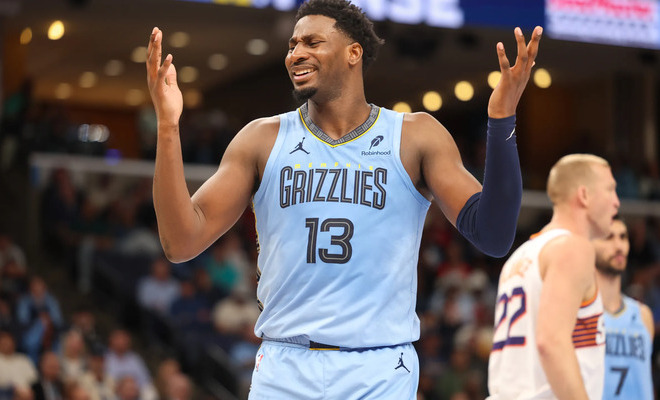-
 June 9, 2025, 10:36 pm
June 9, 2025, 10:36 pmLast Updated on June 9, 2025 10:36 pm by Keston Paul | Published: June 9, 2025
After an injury-ravaged 2023-24 season, the Grizzlies somewhat got back on track. 48 wins and a playoff appearance in a tough Western Conference should be seen as a successful bounce-back campaign. However, varied results and potential tension in the locker room led to a shocking coach firing towards the end of the season, and a whimpering playoff display now leaves the team with more doubts than hopes.
How’d It Go?
At the very least, the season didn’t go worse than 2023-24! Their core of Ja Morant, Jaren Jackson Jr., and Desmond Bane stayed relatively healthy, playing an average of 64 games. While one could have some minor quibbles with their performances, overall, they contributed about what you would have expected. Role players Scotty Pippen Jr. and Santi Aldama each took a step forward, developing into crucial rotation pieces and delivering reliable spot starts when called upon. Ninth-overall pick Zach Edey had some polarizing moments throughout the year but otherwise produced well with strong rebounding impacts and efficient finishing near the basket. Jaylen Wells quickly leveled up from an unheralded second-round pick to a key starter due to his spacing and defensive work.
That probably sounds like all sunshine and roses, but underlying issues would soon lead to changes in the team. Marcus Smart failed to stay healthy yet again, leading to a trade deadline salary dump of his contract. Rotation player Jake LaRavia finally showed some promise, but before the season started the Grizzlies declined to pick up his fourth-year rookie option. With no guarantee they could retain his rights for next season, they opted to trade away a helpful rotation player for some future draft capital. The final straw was the fact that the Grizzlies had a 14-25 record against teams who had an above 50% win rate. This compelled the front office to fire head coach Taylor Jenkins on March 28th, one of the latest head coach firings for a playoff team that we have ever seen. Assistant coach Tuomas Iisalo was promoted to interim head coach and later hired as the full-time head coach.
Amidst all this turmoil, it is not surprising the team flamed out in the playoffs, getting swept by the Thunder in an uninspiring showing. The Grizzlies enter the off-season with a slew of questions on how to best proceed given the relative lack of success the last five seasons. One could argue a roster shake-up needs to occur, but the more likely outcome is some rejiggering around the edges of the roster to allow Iisalo some time to see if he can drive this core to new heights.
Coaching
Perhaps there were some tea leaves that the front office were not the biggest Jenkins fans. In the off-season, the Grizzlies brought in six new assistant coaches with only two holdovers from the 2023-24 season. Reporting indicates that these assistants were brought in without Jenkins’ involvement, which never feels like a positive sign. A new egalitarian offensive approach was to be implemented, stressing driving and occupying empty spaces over the utilization of staples like pick-and-roll concepts. This new approach was supposedly brought forth via new assistant coach Noah LaRoche. Initially, it all seemed to work well. The team thrived on driving to the basket and creating a sort of organized chaos, leading many to praise this new offensive system.
As the year dragged on for the Grizzlies, the offensive impact waned. Ineptitude against the top teams and some potential star player discontent with the offense led to Jenkins’ firing as detailed above, along with LaRoche’s firing. The organization quickly promoted Iisalo to the interim and then full-time head coach role, indicating that perhaps the Grizzlies wanted him to be their head coach all along. Nine regular season and four playoff games is not enough time to judge Iisalo, who will have a full off-season to install his own offensive schemes.
Iisalo comes with high pedigree. He was voted EuroCup Coach of the Year for the 2023-24 season, orchestrating Paris Basketball’s EuroCup Finals victory and a LNB Pro A Leaders Cup and subsequently earning Coach of the Year in the LNB Pro A. He should be given some slack for the Grizzlies’ playoff struggles this season. What changes, if any, he makes to playing time, rotations, and the roster need to be closely monitored by fantasy managers to determine if any gems arise from the switch.
The Players
Jaren Jackson Jr.PF, Memphis GrizzliesSeason Team GP GS MPG FGM FGA FG% FTM FTA FT% 3PTM 3PTA 3PT% PTS REB AST STL BLK TO 25-26 MEM 24 24 29.4 6.5 13.6 47.9 2.8 3.7 76.1 1.6 4.6 34.5 17.4 5.0 2.0 0.8 1.2 2.0 24-25 MEM 74 74 29.8 8.0 16.4 48.8 4.2 5.4 78.1 2.0 5.3 37.5 22.2 5.6 2.0 1.2 1.5 2.1 23-24 MEM 66 66 32.2 7.8 17.6 44.4 5.1 6.3 80.8 1.8 5.5 32.0 22.5 5.5 2.3 1.2 1.6 2.4 ADP: 37.2/65.1 (Yahoo/ESPN) | Total Value: 20/16 (8/9-cat) | Per-Game Value: 39/31 (8/9-cat)
Last year, Jackson expanded his scoring role in an injured Grizzlies season while suffering an efficiency drop. This season, Jackson lived the best of both worlds. His points per game stayed strong at 22.2 PPG while hitting 48.8% from the field. The return of Morant and Bane for a majority of the year certainly helped alleviate the primary creation duties for Jackson, but don’t let that distract you from the gains Jackson has made in his age-25 season. He upped his two-point percentage from 50.1% to 54.1% and his three-point percentage from 32.0% to 37.5%, both stout numbers compared to his career averages. We saw Jackson utilize a powerful drive game last year to raise his involvement in the offense, and he continued to display that addition to his game this season.
Much of his additional stat set was maintained. Even though Jackson has center eligibility, his 5.6 rebounds a game wouldn’t really indicate that. 2.0 threes and 1.2 steals help mitigate the low rebounds, which allow Jackson to be an intriguing player to operate from your center position and provide you those non-typical center stats. The only true disappointment is that Jackson’s blocks held at 1.5 a game, well below his prior peak of 3.0 a game in his Defensive Player of the Year season back in 2023-24. Managers may feel let down by Jackson not being the same force in this category. Keep in mind that his 1.5 blocks a game were still seventh amongst qualifying players. He’s not the same influence in that category, but he remains a positive one.
All in all, Jackson is a versatile center option that can fit a variety of builds. I would argue the points are more valuable than the blocks and allow you flexibility as your draft progresses. Managers should be targeting Jackson around the end of the second round in their fantasy drafts next season.
Ja MorantPG, Memphis GrizzliesSeason Team GP GS MPG FGM FGA FG% FTM FTA FT% 3PTM 3PTA 3PT% PTS REB AST STL BLK TO 25-26 MEM 14 14 28.0 5.8 16.2 35.7 5.2 5.6 92.4 0.9 4.8 19.4 17.7 3.5 7.5 0.9 0.2 3.6 24-25 MEM 50 50 30.4 8.1 17.8 45.4 5.3 6.4 82.4 1.8 5.7 30.9 23.2 4.1 7.3 1.2 0.2 3.7 23-24 MEM 9 9 35.3 8.9 18.9 47.1 5.8 7.1 81.2 1.6 5.7 27.5 25.1 5.6 8.1 0.8 0.6 3.0 ADP: 35.1/15.0 (Yahoo/ESPN) | Total Value: 96/149 (8/9-cat) | Per-Game Value: 50/88 (8/9-cat)
Morant’s ADP continues to baffle me every time I see it. I know he’s fun to watch and creates a ton of highlight-reel moments. Even when he’s healthy though, Morant basically just impacts two categories – points and assists. You know I think those are the two most important categories in fantasy, but you have to do more than only that to be drafted highly. I don’t want to sound too negative, since 23.2 points and 7.3 assists a game don’t grow on trees. At his best, Morant is one of the most dynamic drivers in the game, getting to the rim with force and drawing most of the defense’s attention. He can then capitalize on those drives with either his passing vision to hit up teammates or just using his athleticism to finish at the rim.
We have to balance out those positives with the negatives. Morant’s shooting remains suspect, with just 1.8 triples a game at a 30.9% clip and at below-average volume. The rebounds and steals are fine at 4.1 and 1.2 a game respectively, but that also isn’t changing your fortunes. The turnovers are hurtful at 3.7 a game, although how much you care about that category may vary. Saving the worst for last, Morant cannot stay healthy. The team reduced Morant’s workload, playing him in only 30.4 minutes game and the lowest average of his career. Even with those efforts, nagging injuries kept him in and out of the line-up at just 50 games played overall. As evidenced by his total value ranks above, Morant doesn’t come close to approaching his per-game value.
Morant is one of those players that gets over-drafted year in and year out. To actually match that ADP, Morant would need to add some more positive categories to his repertoire and play in a larger share of games. If you want to bet on all of that happening, be my guest. I for one will almost certainly be passing on Morant at his ADP.
Want access to the rest of this Season Wrap? You’ll need to have a FANTASYPASS membership. Click here to learn more and sign up!
